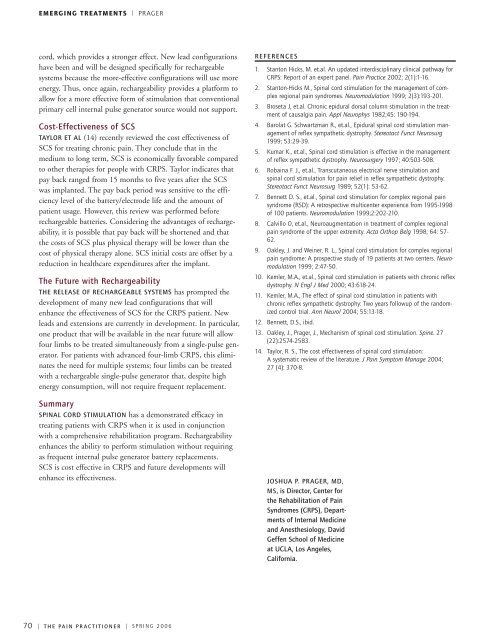printer-friendly version (PDF) - Reflex Sympathetic Dystrophy ...
printer-friendly version (PDF) - Reflex Sympathetic Dystrophy ...
printer-friendly version (PDF) - Reflex Sympathetic Dystrophy ...
You also want an ePaper? Increase the reach of your titles
YUMPU automatically turns print PDFs into web optimized ePapers that Google loves.
EMERGING TREATMENTS | PRAGER<br />
cord, which provides a stronger effect. New lead configurations<br />
have been and will be designed specifically for rechargeable<br />
systems because the more-effective configurations will use more<br />
energy. Thus, once again, rechargeability provides a platform to<br />
allow for a more effective form of stimulation that conventional<br />
primary cell internal pulse generator source would not support.<br />
Cost-Effectiveness of SCS<br />
TAYLOR ET AL (14) recently reviewed the cost effectiveness of<br />
SCS for treating chronic pain. They conclude that in the<br />
medium to long term, SCS is economically favorable compared<br />
to other therapies for people with CRPS. Taylor indicates that<br />
pay back ranged from 15 months to five years after the SCS<br />
was implanted. The pay back period was sensitive to the efficiency<br />
level of the battery/electrode life and the amount of<br />
patient usage. However, this review was performed before<br />
rechargeable batteries. Considering the advantages of rechargeability,<br />
it is possible that pay back will be shortened and that<br />
the costs of SCS plus physical therapy will be lower than the<br />
cost of physical therapy alone. SCS initial costs are offset by a<br />
reduction in healthcare expenditures after the implant.<br />
The Future with Rechargeability<br />
THE RELEASE OF RECHARGEABLE SYSTEMS has prompted the<br />
development of many new lead configurations that will<br />
enhance the effectiveness of SCS for the CRPS patient. New<br />
leads and extensions are currently in development. In particular,<br />
one product that will be available in the near future will allow<br />
four limbs to be treated simultaneously from a single-pulse generator.<br />
For patients with advanced four-limb CRPS, this eliminates<br />
the need for multiple systems; four limbs can be treated<br />
with a rechargeable single-pulse generator that, despite high<br />
energy consumption, will not require frequent replacement.<br />
Summary<br />
SPINAL CORD STIMULATION has a demonstrated efficacy in<br />
treating patients with CRPS when it is used in conjunction<br />
with a comprehensive rehabilitation program. Rechargeability<br />
enhances the ability to perform stimulation without requiring<br />
as frequent internal pulse generator battery replacements.<br />
SCS is cost effective in CRPS and future developments will<br />
enhance its effectiveness.<br />
REFERENCES<br />
1. Stanton Hicks, M. et.al. An updated interdisciplinary clinical pathway for<br />
CRPS: Report of an expert panel. Pain Practice 2002; 2(1):1-16.<br />
2. Stanton-Hicks M., Spinal cord stimulation for the management of complex<br />
regional pain syndromes. Neuromodulation 1999; 2(3):193-201.<br />
3. Broseta J, et.al. Chronic epidural dorsal column stimulation in the treatment<br />
of causalgia pain. Appl Neurophys 1982;45: 190-194.<br />
4. Barolat G. Schwartzman R., et.al., Epidural spinal cord stimulation management<br />
of reflex sympathetic dystrophy. Stereotact Funct Neurosurg<br />
1999; 53:29-39.<br />
5. Kumar K., et.al., Spinal cord stimulation is effective in the management<br />
of reflex sympathetic dystrophy. Neurosurgery 1997; 40:503-508.<br />
6. Robaina F. J., et.al., Transcutaneous electrical nerve stimulation and<br />
spinal cord stimulation for pain relief in reflex sympathetic dystrophy.<br />
Stereotact Funct Neurosurg 1989; 52(1): 53-62.<br />
7. Bennett D. S., et.al., Spinal cord stimulation for complex regional pain<br />
syndrome (RSD): A retrospective multicenter experience from 1995-1998<br />
of 100 patients. Neuromodulation 1999;2:202-210.<br />
8. Calvillo O, et.al., Neuroaugmentation in treatment of complex regional<br />
pain syndrome of the upper extremity. Acta Orthop Belg 1998; 64: 57-<br />
62.<br />
9. Oakley, J. and Weiner, R. L., Spinal cord stimulation for complex regional<br />
pain syndrome: A prospective study of 19 patients at two centers. Neuromodulation<br />
1999; 2:47-50.<br />
10. Kemler, M.A., et.al., Spinal cord stimulation in patients with chronic reflex<br />
dystrophy. N Engl J Med 2000; 43:618-24.<br />
11. Kemler, M.A., The effect of spinal cord stimulation in patients with<br />
chronic reflex sympathetic dystrophy: Two years followup of the randomized<br />
control trial. Ann Neurol 2004; 55:13-18.<br />
12. Bennett, D.S., ibid.<br />
13. Oakley, J., Prager, J., Mechanism of spinal cord stimulation. Spine. 27<br />
(22):2574-2583.<br />
14. Taylor, R. S., The cost effectiveness of spinal cord stimulation:<br />
A systematic review of the literature. J Pain Symptom Manage 2004;<br />
27 (4): 370-8.<br />
JOSHUA P. PRAGER, MD,<br />
MS, is Director, Center for<br />
the Rehabilitation of Pain<br />
Syndromes (CRPS), Departments<br />
of Internal Medicine<br />
and Anesthesiology, David<br />
Geffen School of Medicine<br />
at UCLA, Los Angeles,<br />
California.<br />
70 | T H E PA I N P R A C T I T I O N E R | S P R I N G 2 0 0 6
















